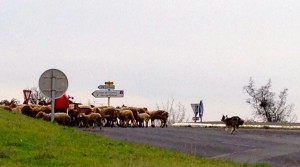It is an unmistakable sound, though it may take a city boy a minute or two to place it.
The steady “tinkle ” or “clank” of domesticated animals wearing bells, maybe just the other side of a rise of land, and on the move.
A combined herd of sheep and goats is being raised somewhere near where we are staying, on the edge of a small town in the Languedoc, and while walking today we saw the group of 40 to 50 individuals — crossing the busiest highway coming out of the center of the town.
It was fascinating to watch from 30 yards or so away, and quite the operation, one that required four or five shepherds to pull off.
Only one of the shepherds was a human. The rest were dogs.
Herding dogs are a marvel to watch. They lead and the animals follow, aside from those who veer left or right, or lag behind.
And the dogs see to it that the those who stray too far from the herd are cajoled/threatened back toward the group — without barking.
The one human who was part of the show seemed to be directing the dogs with an occasional whistle. The dogs did the rest on their own, just knowing what they wanted to do and how to do it.
Most of the rest of what the human shepherd did was make the decisions about where to pasture the animals — and when to cross barriers like roads.
The dogs did the rest.
It was a diverse herd. About 30 sheep, with at least one big male with circular ram’s horns, and the rest goats, with at least one wearing the antlers of an adult male.
The dogs seemed to enjoy the responsibility.
They seemed almost contemptuous of the sheep and goats. “Keep up, stupid.” That sort of thing. Though the dogs are not abusive — we saw no nipping and heard no barking. Maybe, too, the dogs realize they are dealing with a species not as smart as they are, and feel a responsibility to keep them out of harm’s way.
They certainly have a knack for quickly spotting the animals who risk getting separated from the flock. The dogs run ahead of the straying animal, then slow their pace till the animal has no choice but to veer back to the herd.
The dogs also seem to enjoy getting those in the back to move, often by lunging left or right within a few feet of the laggards in what must appear to be (to the herd animal) semi-threatening behavior.
They can turn the direction of the herd by coaxing lead animals to turn right or left — essentially by cutting off other directions with their presence. Or they can stop dead in front of them and the herd will also stop, and begin foraging.
Apparently, “all herding behavior is predatory behavior”, modified over the centuries by human shepherds, through selection or training.
This part of France has quite a bit of grass and edible weeds, this time of year, mostly on undeveloped land or former vineyards no longer being kept up.
Our landlord said he knew the young man who keeps the herd, raised to produce meat, cheese or milk, and said he moves the sheep and goats around the area — one day here, the next day across a road, the day after on the other side of town. Cropping. Eating their fill. Keeping down the weeds. Saving the owner the coast of commercial feed.
In a few days, we were told, the herd might be within a few yards of where we are staying.
Which we hope to hear, via the bells … and then go and watch the dogs operate, again.


1 response so far ↓
1 George Alfano // Feb 28, 2016 at 4:24 PM
It’s not like we don’t hear cow bells in California. Have we forgotten Sacramento Kings fans in the playoffs. 🙂
Leave a Comment